
Cheddar cheese is a natural cheese that is relatively hard, off-white, and sometimes sharp-tasting. Cheddar originates from the English village of Cheddar in Somerset.

Mozzarella is a semi-soft non-aged cheese by the pasta filata method with origins from southern Italy.

Halloumi or haloumi is a cheese of Cypriot origin made from a mixture of goat's and sheep's milk, and sometimes also cow's milk. Its texture is described as squeaky. It has a high melting point and so can easily be fried or grilled, a property that makes it a popular meat substitute. Rennet is used to curdle the milk in halloumi production, although no acid-producing bacteria are used in its preparation.

Stilton is an English cheese, produced in two varieties: Blue, which has Penicillium roqueforti added to generate a characteristic smell and taste, and White, which does not. Both have been granted the status of a protected designation of origin (PDO) by the European Commission, requiring that only such cheese produced in the three counties of Derbyshire, Leicestershire and Nottinghamshire may be called Stilton. The cheese takes its name from the village of Stilton, now in Cambridgeshire, where it has long been sold.
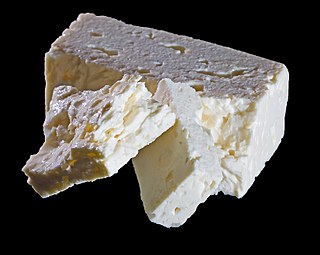
Feta is a Greek brined white cheese made from sheep's milk or from a mixture of sheep and goat's milk. It is soft, with small or no holes, a compact touch, few cuts, and no skin. Crumbly with a slightly grainy texture, it is formed into large blocks and aged in brine. Its flavor is tangy and salty, ranging from mild to sharp. Feta is used as a table cheese, in salads such as Greek salad, and in pastries, notably the phyllo-based Greek dishes spanakopita "spinach pie" and tyropita "cheese pie". It is often served with olive oil or olives, and sprinkled with aromatic herbs such as oregano. It can also be served cooked, as part of a sandwich, in omelettes, and many other dishes.

Parmesan is an Italian hard, granular cheese produced from cows' milk and aged at least 12 months.

Goat cheese, goat's cheese, or chèvre is cheese made from goat's milk. Goats were among the first animals to be domesticated for producing food. Goat cheese is made around the world with a variety of recipes, giving many different styles of cheeses, from fresh and soft to aged and hard.

Grana Padano is a cheese originating in the Po river Valley in northern Italy that is similar to Parmigiano Reggiano. There are less strict regulations governing its production compared to Parmigiano Reggiano. This hard, crumbly-textured cheese is made with unpasteurized cows' milk that is semi-skimmed through a natural creaming process. To preserve the authenticity of the manufacturing processes and raw materials used to make this cheese, Grana Padano is registered as Geographical Indication in Italy since 1954 and as a European Union protected designation of origin (PDO) since 1996, and is protected in several other countries based on the Lisbon Agreement and bilateral agreements.

Castelo Branco is a cheese named after the city of the same name in Portugal, the main city of the district where it is produced.

Pecorino sardo is a firm cheese from the Italian island of Sardinia which is made from sheep milk: specifically from the milk of the local Sardinian breed. It was awarded denominazione d'origine status in 1991 and granted protected designation of origin protection in 1996, the year in which this European Union certification scheme was introduced.

Bergkäse refers to a number of varieties of cheese produced in the Alps. This includes products of mountain farming, the cultivation of alpine pastures as well as the milk processing of local producers in dairies. The term does not say much about the type or production method of the product called mountain cheese, which is usually a hard or semi-hard cheese with no or little holes, usually with a natural rind, but there are also semi-hard cheeses and soft cheeses under this designation. The term is used also generically for Swiss-type or Alpine cheeses, which resemble these in taste and texture but do not come from one of the traditional cheese making regions. The texture is rather hard, sometimes with small holes or cracks, the flavour strong and often a bit nutty.

Serra da Estrela cheese is a cheese made in the mountainous region of Serra da Estrela in Portugal. Under the name "Queijo Serra da Estrela" it is a Protected designation of origin (PDO) in the European Union as well as the UK.
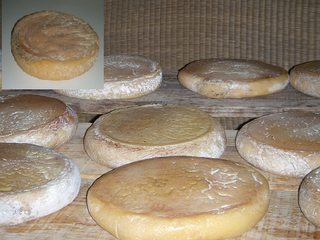
Queso de La Serena is a cheese made from Merino sheep milk in the comarca (district) of La Serena, in Extremadura, Spain. The pure sheep milk is curdled using a coagulant found in the pistils of cardoon. This ingredient lends a light bitterness to the otherwise slightly salty taste. It is aged for at least sixty days. When the cheese has a creamy consistency in the centre, it is traditionally eaten by slicing off the top and scooping out the inside with a spoon, and it is known as Torta de La Serena. If it is allowed to mature further it becomes harder, develops a stronger taste and is known as Queso de La Serena.
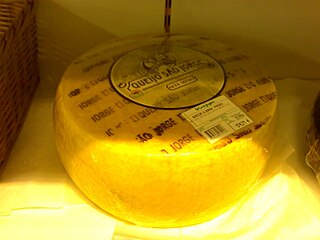
São Jorge Cheese is a semi-hard to hard cheese, produced on the island of São Jorge, in the Portuguese archipelago of the Azores, certified as a Região Demarcada do Queijo de São Jorge and regulated as a registered Denominação de Origem Protegida.

Queijo de Nisa is a semi-hard sheep's milk cheese from the municipality of Nisa, in the subregion of Alto Alentejo in Portugal. It is created from raw milk, which is coagulated, then curdled using an infusion of thistle. It is yellowish white, with a robust flavor and a somewhat acidic finish.
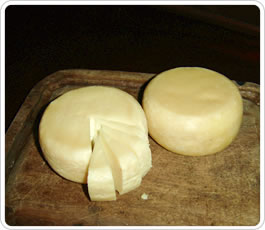
Colony cheese is a type of cheese made in the highlands of the Brazilian state of Rio Grande do Sul and in Uruguay. It is one of the icons of southern Brazilian cuisine, also being produced in Santa Catarina, despite being originally from Uruguay.
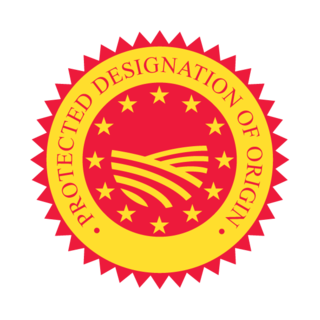
The protected designation of origin (PDO) is a type of geographical indication of the European Union and the United Kingdom aimed at preserving the designations of origin of food-related products. The designation was created in 1992 and its main purpose is to designate products that have been produced, processed and developed in a specific geographical area, using the recognized know-how of local producers and ingredients from the region concerned.
















